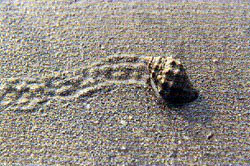SWEDISH SOUTH ASIAN STUDIES NETWORK
Marine Geology; Department of Earth Sciences, at Göteborg University:
Postal address: Box 460, SE-405 30, Göteborg,
Sweden
Visiting address: Guldhedsgatan 5A
Web page: http://www.gvc.gu.se
 Contact person: PhD Johan
Burman, phone +46 (0)31 773 1875
Contact person: PhD Johan
Burman, phone +46 (0)31 773 1875
Marine Geology is a part of the Department of Earth Sciences, in which is also included the subjects of Oceanography, Physical Geography and Geology.
Research at the department connected to South Asia:
Johan Burman defended his
doctoral dissertation on ”Stable Oxygen and
Carbon Isotopes in Recent and Subfossil Littorinidae Shells – a
high resolution method for paleoenvironmental reconstructions” on
Friday 2 June 2006. Faculty opponent was Associate Professor Dan Hammarlund,
Dept. of Geology, Lund University. The research deals with stable isotopes
using gastropods as a tool to deduce present and past (paleo)-monsoon
variability, and the the thesis consists of five papers and manuscripts.
Read
an abstract of the thesis (as a pdf-file). ![]()
One of the papers dealt with material from the Indian Ocean.
This part of the project was carried out during 2004-05, in collaboration
with Dr Divakar
P Naidu, National Institute of Oceanography, Dona Paula, Goa,
India and Professor Birger Schmitz, Lund
University, Sweden. In November 2003 they received SEK 300 000 as a
grant from Sida/SAREC to carry out this project, then titled ”Marine
gastropod intrashell stable isotope records as a tool to deduce Holocene
monsoon variability along the South-West coast of India”.
 The
aim was to apply a new high-sensitivity method to reconstruct
intra-annual temperature and salinity variations, and apply it in
reconstructions of monsoon variability across the Arabian Sea. In
the research group it was shown that by establishing intrashell
stable isotopic ò18
O profiles from marine gastropod shells (Littoraria
undulata, photo to
the right), time-resolution improves towards a seasonal precision.
By comparing seasonal isotopic records of recent and mid-Holocene (7
000-5 000 B.P.) shells, they contributed a completely new perspective
on SST (sea surface temperature) and SSS (sea surface salinity) changes
in the southeast Arabian Sea and its relation to regional monsoon variability.
Such SST and SSS data will provide the basis for refined modelling
of the response of the monsoon system to future potential greenhouse
conditions.
The
aim was to apply a new high-sensitivity method to reconstruct
intra-annual temperature and salinity variations, and apply it in
reconstructions of monsoon variability across the Arabian Sea. In
the research group it was shown that by establishing intrashell
stable isotopic ò18
O profiles from marine gastropod shells (Littoraria
undulata, photo to
the right), time-resolution improves towards a seasonal precision.
By comparing seasonal isotopic records of recent and mid-Holocene (7
000-5 000 B.P.) shells, they contributed a completely new perspective
on SST (sea surface temperature) and SSS (sea surface salinity) changes
in the southeast Arabian Sea and its relation to regional monsoon variability.
Such SST and SSS data will provide the basis for refined modelling
of the response of the monsoon system to future potential greenhouse
conditions.
In June 2007, Dr. Burman received SEK 935 000 as a three-years
grant (2007–09) for an application to the Joint Formas – Sida/SAREC programme for research
on sustainable development in developing countries, for a project titled ”Indian paleomonsoon dynamics; linking high-resolution terrestrial and marine records”. More
information on the project (only in Swedish). This project is also carried out in collaboration with Dr. Divakar Naidu at the National Institute of Oceanography in Goa, India. Johan Burman presented the project in a panel on ”Climate change and future scenarios in poor countries” at the Sida-funded conference on current Swedish development research titled ”Meeting Global Challenges in Research Cooperation” that was jointly organised by Uppsala University and the Swedish University of Agricultural Sciences (SLU) in Uppsala 27-29 May 2008 (more information about the conference). ![]()
Abstract to project: The Indian monsoon system is an important component of the global climate and has
unparalleled societal impact for people’s life in the region. Our ability to forecast the monsoon
intensity depends on the understanding of recent atmospheric and oceanographic settings. It is
necessary to develop highly reliable proxies, which can enable enhanced palaeointerpretations,
especially on short time-scales. If we are to understand the background of natural variability
underlying anthropogenic climate change, it is important to concentrate on climate of the past.
Thus, an increased understanding of climate variability on Earth during the Holocene period is
crucial in order to predict the future climate. In this context, oxygen and carbon isotopic analyses
of the intertidal gastropod Littoraria undulata were carried out from southwest India, in order to
reconstruct intra-annual monsoon signals and sea-surface temperatures. The average resolution
in the aragonite shells of Littoraria undulata was determined to 4 days per sample, based on a
tag and release experiment that showed growth rates of ca. 0.15 mm per day–1. The gastropod
shells from south Karnataka (13°N) displayed a seasonal δ13C shift of 3‰ and enriched values
during the post monsoon season. This indicated increased surface-water productivity by primary
producers, linked to seasonal upwelling. In contrast, gastropod shells from Goa (15°N) showed
depleted δ13C values, pointing towards less pronounced upwelling intensity in the coastal zone of
this region. Reconstructed modern mean annual sea-surface temperatures derived from δ18O
fractionation in the Littoraria undulata shells deviated less than 0.6 °C compared with observed
values, and showed an overall precision of ±0.8 °C. Tentative results suggest that carbonate δ18O
and δ13C values of the intertidal gastropod Littoraria undulata, can be used as a proxy for
seasonality studies in the Arabian Sea. In a future perspective, similar assessments of mean
annual sea-surface temperature and seasonal upwelling and its relation to the strenght of the
south-west monsoon can be made from either Littoraria undulata or related species in fossil
records. This first step in developing a proxy stable isotope method through analyses of gastropod
shells in recent times, open up new opportunities for alaeointerpretation of the climatic system
of south India. ![]()
SASNET - Swedish South Asian Studies Network/Lund
University
Address: Scheelevägen 15 D, SE-223 70 Lund, Sweden
Phone: +46 46 222 73 40
Webmaster: Lars Eklund
Last updated
2008-05-30
